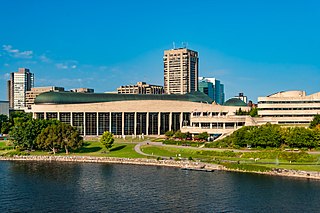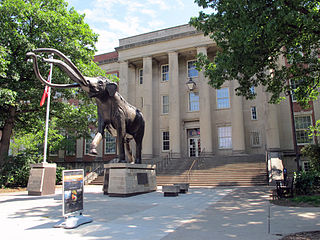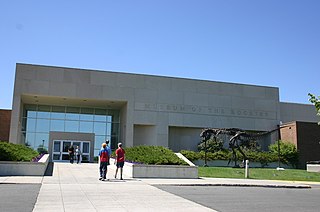
Idaho Falls is the fourth most populous city in Idaho and the county seat of Bonneville County. It is the state's most populous city outside the Boise metropolitan area. As of the 2020 census, the population of Idaho Falls was 64,818. In the 2010 census, the population of Idaho Falls was 56,813, with a metro population of 133,265.

The Natural History Museum in London is a museum that exhibits a vast range of specimens from various segments of natural history. It is one of three major museums on Exhibition Road in South Kensington, the others being the Science Museum and the Victoria and Albert Museum. The Natural History Museum's main frontage, however, is on Cromwell Road.

The Royal Ontario Museum (ROM) is a museum of art, world culture and natural history in Toronto, Ontario, Canada. It is one of the largest museums in North America and the largest in Canada. It attracts more than one million visitors every year, making the ROM the most-visited museum in Canada. The museum is north of Queen's Park, in the University of Toronto district, with its main entrance on Bloor Street West. Museum subway station is named after the ROM and, since a 2008 renovation, is decorated to resemble the institution's collection at the platform level.

The Canadian Museum of History is a national museum on anthropology, Canadian history, cultural studies, and ethnology in Gatineau, Quebec, Canada. The purpose of the museum is to promote the heritage of Canada, as well as support related research. The museum is based in a 75,000-square-metre-building (810,000 sq ft) designed by Douglas Cardinal.

The Field Museum of Natural History (FMNH), also known as The Field Museum, is a natural history museum in Chicago, Illinois, and is one of the largest such museums in the world. The museum is popular for the size and quality of its educational and scientific programs, and its extensive scientific specimen and artifact collections. The permanent exhibitions, which attract up to 2 million visitors annually, include fossils, current cultures from around the world, and interactive programming demonstrating today's urgent conservation needs. The museum is named in honor of its first major benefactor, Marshall Field, the department-store magnate. The museum and its collections originated from the 1893 World's Columbian Exposition and the artifacts displayed at the fair.

The Museum of History & Industry (MOHAI) is a history museum in the South Lake Union neighborhood of Seattle, Washington, United States. It is the largest private heritage organization in Washington state, maintaining a collection of nearly four million artifacts, photographs, and archival materials primarily focusing on Seattle and the greater Puget Sound region. A portion of this collection is on display in the museum's galleries at the historic Naval Reserve Armory in Lake Union Park.

The University of Nebraska State Museum, also known as Morrill Hall, founded in 1871, is a natural history museum featuring Nebraska biodiversity, paleontology, and cultural diversity, located on the University of Nebraska–Lincoln City Campus near the corner of 14th and Vine Streets in Lincoln, Nebraska, United States. The museum houses Mueller Planetarium, a hands-on science discovery center, and the Elephant Hall, where visitors can see the world's largest articulated fossil mammoth among the collection of fossil elephants. Also featured are interactive paleontology exhibits, a dinosaur gallery, ancient life and evolution exhibits, wildlife dioramas, gems and minerals, American Indian and African exhibits, and a temporary exhibit gallery featuring rotating displays on diverse topics including photography, quilts and fine arts.

Museum of the Rockies is a museum in Bozeman, Montana. Originally affiliated with Montana State University in Bozeman, and now also, the Smithsonian Institution. The museum is largely known for its Paleontological collections as well as having the largest collection of North American Dinosaur fossils in the United States. They also possess the largest Tyrannosaurus skull ever discovered, as well as the thigh bone of a Tyrannosaurus Rex that contains soft-tissue remains. The museum is part of the Montana Dinosaur Trail and is Montana's official repository for Paleontological specimens.

The Royal Alberta Museum (RAM) is a museum of human and natural history in Downtown Edmonton, Alberta, Canada, located north of City Hall. The museum is the largest in western Canada with more than 7,600 square metres (82,000 sq ft) exhibition space and 38,900 square metres (419,000 sq ft) in total.

The Children's Museum of Indianapolis is the world's largest children's museum. It is located at 3000 North Meridian Street, Indianapolis, Indiana in the United Northwest Area neighborhood of the city. The museum is accredited by the American Alliance of Museums. It is 472,900 square feet (43,933.85 m2) with five floors of exhibit halls and receives more than one million visitors annually. Its collection of over 130,000 artifacts and exhibit items is divided into two domains: Arts & Humanities and the Natural Sciences. Among the exhibits are simulated Cretaceous and Jurassic dinosaur habitats, a carousel, a steam locomotive, and the glass sculpture Fireworks of Glass Tower and Ceiling. The museum's focus is family learning; most exhibits are designed to be interactive, allowing children and families to actively participate.

The Milwaukee Public Museum (MPM) is a natural and human history museum in downtown Milwaukee, Wisconsin. The museum was chartered in 1882 and opened to the public in 1884; it is a not-for-profit organization operated by the Milwaukee Public Museum, Inc. MPM has three floors of exhibits and the first Dome Theater in Wisconsin.

The Santa Cruz Museum of Natural History, also known affectionately by locals as "the Whale Museum", is one of the earliest museums in the state of California. Founded from the Laura Hecox collection in 1905, the museum's collections grew extensively throughout the years, acquiring many Native American and archaeological artifacts, as well as natural history specimens. Currently, the museum is housed in a Carnegie Library, named after the Carnegie philanthropic foundation that funded the construction of the library in 1915.

The Arizona Museum of Natural History located in Mesa, Arizona, is the only natural history museum in the greater Phoenix area. It exhibits the natural and cultural history of the Southwestern United States.

The Prehistoric Museum, USU-Eastern, formerly known as the College of Eastern Utah Prehistoric Museum, is a museum accredited by the American Alliance of Museums located in Price, Utah. The museum seeks to promote public understanding of prehistory through interpretive exhibits, educational programs, collections, and research. The museum is located near many paleontological and archaeological sites in a region known as Castle Country, notably in the San Rafael Swell and nearby canyons throughout the Book Cliffs area such as Nine Mile Canyon and Range Creek Canyon.

The Idaho Museum of Natural History (IMNH) is the official state natural history museum of Idaho, located on the campus of Idaho State University (ISU) in Pocatello. Founded in 1934, it has collections in anthropology, vertebrate paleontology, earth science, and the life sciences. Additionally, it contains an archive of documents and ethnographic photographs.

The Western Science Center (WSC), formerly the Western Center for Archaeology & Paleontology, is a museum located near Diamond Valley Lake in Hemet, California. The WSC is home to a large collection of Native American artifacts and Ice Age fossils that were unearthed at Diamond Valley Lake, including "Max", the largest mastodon found in the western United States, and "Xena", a Columbian mammoth, as well as dinosaur fossils recovered from New Mexico.

The University of Michigan Museum of Natural History is a natural history museum of the University of Michigan in Ann Arbor, Michigan, United States.
The Herrett Center for Arts and Science, located on the main campus of the College of Southern Idaho in Twin Falls, Idaho, USA, is a museum of anthropology, natural history, astronomy, and art. The museum's collections primarily comprise anthropological artifacts and natural history specimens from the Americas, as well as works of local artists. The Center also houses the Faulkner Planetarium, the Centennial Observatory, a museum store, and a 2900 square foot multi-purpose event space.

The Kelsey Museum of Archaeology is a museum of archaeology located on the University of Michigan central campus in Ann Arbor, Michigan, in the United States. The museum is a unit of the University of Michigan's College of Literature, Science, and the Arts. It has a collection of more than 100,000 ancient and medieval artifacts from the civilizations of the Mediterranean and the Near East. In addition to displaying its permanent and special exhibitions, the museum sponsors research and fieldwork and conducts educational programs for the public and for schoolchildren. The museum also houses the University of Michigan Interdepartmental Program in Classical Art and Archaeology.





















